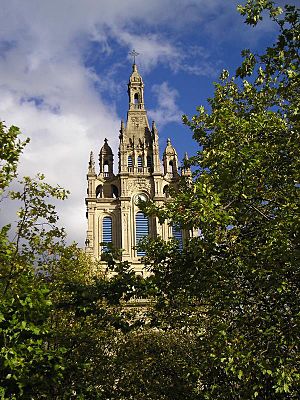Basilica of Begoña facts for kids
Quick facts for kids Basilica of BegoñaBegoñako basilika |
|
|---|---|

Steeple of the basilica.
|
|
| Religion | |
| Affiliation | Roman Catholic |
| District | Begoña |
| Province | Biscay |
| Ecclesiastical or organizational status | Parish |
| Year consecrated | 16th century |
| Location | |
| Location | Bilbao, Spain |
| Architecture | |
| Architectural type | Basilica |
| Architectural style | Gothic and Baroque |
| Specifications | |
| Direction of façade | West |
| Spire(s) | 1 |
| Materials | limestone |
The Basilica of Begoña (also known as Basílica de Nuestra Señora de Begoña in Spanish) is a special church in Bilbao, Spain. It is dedicated to the Virgin Begoña, who is considered the patron saint of Biscay. This beautiful basilica is a very important place for many people.
The current parish priest is Jesús Francisco de Garitaonandia.
Contents
History of the Basilica
The basilica began its life in the 16th century. It was designed by an architect named Sancho Martínez de Arego. The building has three main sections called naves. Workers started building in 1511.
Adding the curved ceilings, known as vaults, took about a century. This work was finished in the 17th century. During this long building period, the Gothic style started to mix with Renaissance ideas.
Architectural Style and Changes
The main entrance, built in the mid-16th century, shows this mix of styles. It has arches that reflect the changing design ideas of the Spanish architect Gil de Hontañón. However, most of the building still looks purely Gothic.
In the 19th century, the basilica was damaged. This happened because it was part of Bilbao's city wall. A general named Tomás de Zumalacárregui was hurt near the basilica during a conflict.
The current tower and some parts of the outside were designed later. José María Basterra created these plans. They were built between 1902 and 1907.
Repairs and Restoration
On August 16, 1942, an incident happened near the church. This event caused some damage to the area. After this, work was done to fix the basilica.
From September 1993 to June 1994, the building had a big cleaning and restoration. Workers cleaned the stone and repaired the clock face and bells. The clock tower holds 24 bells. The heaviest bell weighs about one tonne. These bells were made in Sumiswald, Switzerland. The clock tower itself dates back to 1922. Today, it can play seven different melodies.
La Salve and the Basilica's View
The "La Salve" area of Bilbao has a special name. It means "salute" or "Hail Mary" in Spanish. This area is named because it was the first place where sailors could see the basilica's steeple.
Sailors returning up the Nervión river, which flows through Bilbao, would see the steeple. When they saw it, they would start to pray to the Virgin Begoña. They thanked her for keeping them safe during their time at sea.
Festivals and Celebrations
The main festivals at the Basilica of Begoña happen twice a year. One is on August 15, which is the Assumption of Mary. The other is on October 11, which is the saint day of Begoña.
On these special days, a midnight mass is held. Many people go on pilgrimages to the basilica. Locals and visitors come to worship and celebrate.
The basilica's website mentions that many sailors still remember how important the building is. "Virgen de Begoña" or "Begoña" are popular names for ships and fleets.
The basilica is open to visitors from Monday to Friday. You can visit from 9:30 AM to 1:30 PM and from 4:30 PM to 8:30 PM.
See also
 In Spanish: Basílica de Nuestra Señora de Begoña para niños
In Spanish: Basílica de Nuestra Señora de Begoña para niños
- List of carillons


